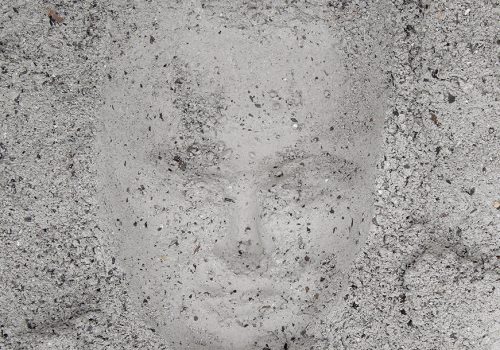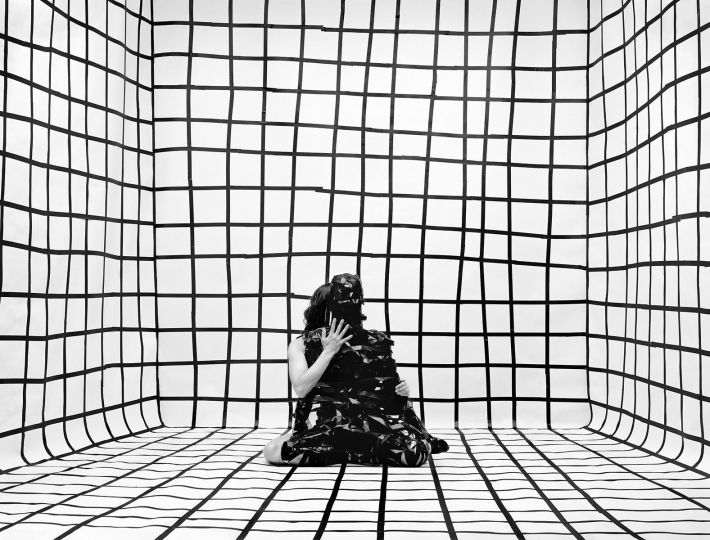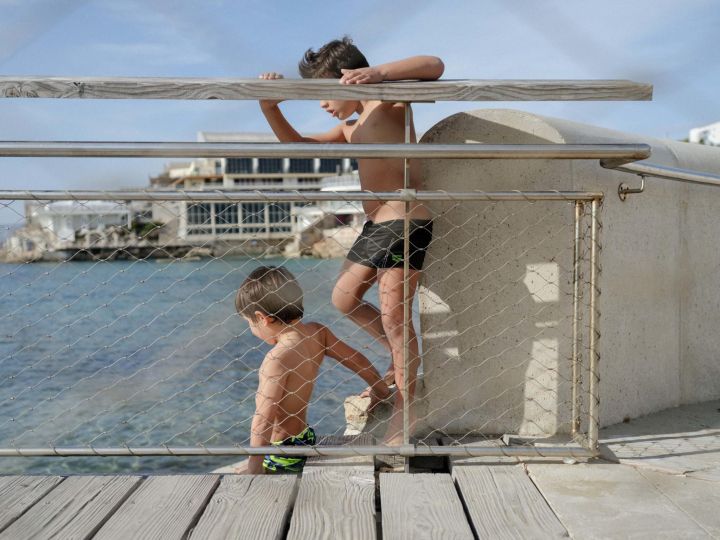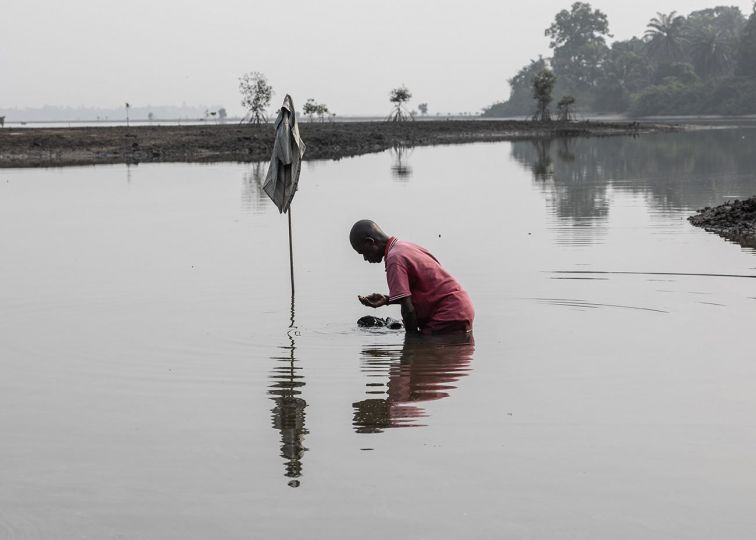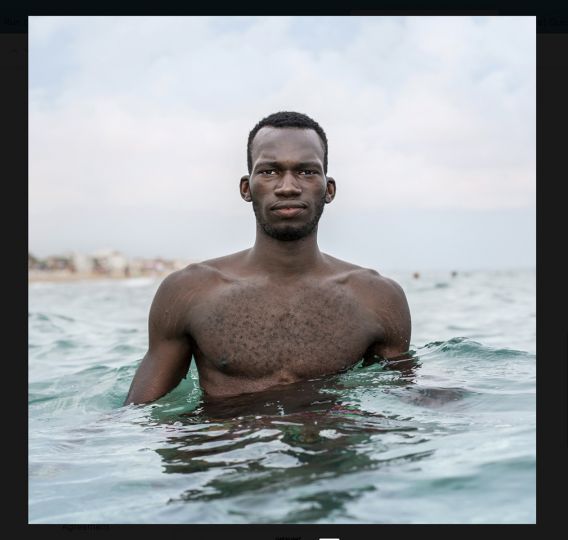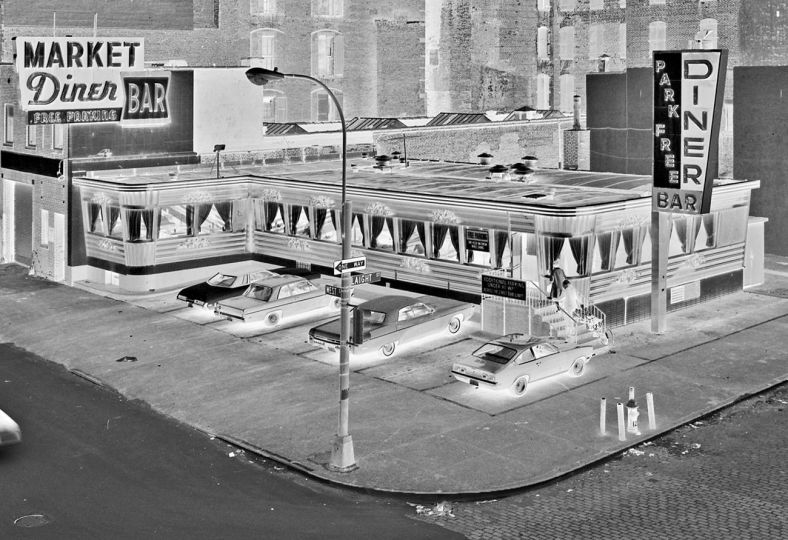Since Musée Réattu founded its photography department in 1965, as a museum of fine arts it has continually engaged in recognising photography as a major art form in its own right on a par with painting and sculpture. What these mediums have in common are a creator, who transcends the technique, and the status of the image, raised to the rank of work of art.
All photographers in the museum collection or those that have featured in exhibitions have contributed to this activist approach. The museum has supported and welcomed many artists whose visual research suited this museum, the former house of the late 18th century painter, Jacques Réattu, winner of the Grand Prix de Rome.
A major part of the collection is therefore dedicated to these so-called plastic artists who use the medium of photography in unusual forms, exploring the mystery surrounding the emergence of images. There are for example Pierre Cordier’s chemigrams, Nancy Wilson-Pajic’s cyanotypes, Yves Trémorin’s electronograms and Katerina Jebb’s scans.
Annabel Aoun Blanco’s work nestles between the approach of a ‘traditional’ photographer and a visual artist making images appear without a camera.
In fact Annabel Aoun Blanco’s ‘tool’ is a camera with all its technical specifications (lens, focus, focal depth, aperture stop, exposure, lighting) devoted as much to the appearance as the disappearance of images. But where research into the almost miraculous appearance of images involves setting aside the camera, Annabel Aoun Blanco embraces it and on the contrary liberates, frees herself from its constraints.
This material approach to constructing images (photography or videos) derives from seeking a ‘passage’ between memory and forgetfulness, appearance and disappearance, life and death, for which she associates a device, gesture and material. Through this she is drawn to explore both photography and video, combining them in a back-and-forth, a round trip, looped dynamic.
Works by the photographer/video artist Annabel Aoun Blanco have found their rightful place in the Musée Réattu, as much through their visual art dimension, as through the emotional response that they trigger, their inclusion in the history of art and this artistic questioning of the spatio-temporal features of the mediums and their boundaries.
The exhibition makes it possible to grasp this work as a whole by presenting photographs and videos facing each other. It captures the entire dimension of the artist’s research as well as the ability of each work to exist in itself, independently but closely connected to the history of the museum and its collections. Only on rare occasions will works developed outside the framework become part of the building so naturally or even supernaturally. The first work that visitors come across is Éloigne moi de toi (take me away from you) the title of which is rather inviting. Souffle draws visitors into the Grande Salle ‘des Troncs’. The artwork Toupie is on the stand, at the intersection of the Order of Malta’s Grand Priory. The series Le Mandylion, desvoilés and desvoilés II appear in the Chapel of Saint-Jean reconnecting it with its essential spiritual dimension. Le Cri is located in the vestry.
This is the first institutional exhibition for Annabel Aoun Blanco who chose Musée Réattu as much as the museum chose her, this project is part of a temporary exhibitions policy closely linked to efforts to expand and enrich the collections. It is as much a starting point as an end point, a round trip…
Daniel Rouvier
Recollection of a certain image…
Pondering Annabel Aoun Blanco’s work by Robert Pujade
At first sight, Annabel Aoun Blanco’s work fits unwillingly within the portrait genre in which one is tempted to place her when looking at the photographs or videos she produces. One observes the advent of shapes of faces as blurry as footprints or as pale as castings, awe-inspiring in their expressions and enticing by the very enigma they conceal, as if they were here to illustrate Pascal’s famous thought: A portrait conveys absence and presence, pleasure and displeasure.[1]Hence, the models utilized to make the portraits seem more imaginary than real. They function as masks and depending on the processing implemented before the shooting, they convoke in turn spectres, mummies, or ghosts. Or sometimes they even become real faces freed of their personality, as in the Avatars series.
The portraits are not here to display an identity. In fact, their “raison d’être” would rather be the highlighting of the faces they reveal, their sole purpose being to reflect the complexity of portraiture and its relation to memory. Annabel Aoun Blanco’s interest lies essentially in remembrance that is the way images of still or animated portraits recall the inconstant and fragile representation, which in fact is the purpose of remembering. This is why live portraits appear at the very beginning of her work, and afterwards make way to direct imprints, to masks, to subjects what are already images. The whole plastic device implemented by the artist is orientated towards memory phenomenology, with photography or video bringing in variable visibility forms, the fleeting impressions felt during the remembrance process. One can also note two appearance and disappearance modalities of these fleeting images.
First, emergence or burial: in the series entitled Danse contemporaine II, characters are immersed in a pool of milk and only their limbs or parts of their faces appear at the surface. In other, more recent series the masks are camouflaged by either too little or too much light (series: Caresses, Eloigne-toi de moi and Décadrés, for example) or hidden by various materials: ash, sand, coal powder, veils. Each time, access to the image occurs at the infinitesimal instant when the subject presence is about to erupt from or to be buried in monochromic oblivion. Those surreptitious appearances are somewhat related to the mythical representation of Ophelia’s death, a theme that has haunted the history of painting. A secondary character in Hamlet, her death told by the queen (Act IV, sc.7) marks, in its description, the fatal moment at which the princess will cease to be visible. The fascination for the boundary between life and death, between appearance and disappearance, and the presence that leaves room for the memory has provided an abundant source of inspiration for painters, which led Rimbaud to write:
Voici plus de mille ans que la triste Ophélie
Passe, fantôme blanc, sur le long fleuve noir[2
For more than a thousand years, sad Ophelia
Has passed, white phantom, down the long black river.
Annabel Aoun Blanco concentrates her creative attention to this metaphorical passage from white to black, as demonstrated by the central image entitled: ∞ (infinite).
The other recurrent appearance-disappearance modality for the image-memory is a “freezed frame”, a fixation on a face almost observable which nevertheless bears the signs of its disaggregation. The effect produced by this vision differs sensibly as a function of the medium utilized.
On certain photographs, the fixation focuses on the appearing of a face that bears the marks of time. The sequence entitled Zoome proposes the burial of the same face imprint, at two different times, in coal powder: from one to the other, one can observe a progression of the devastation of the features and the sequence entitled Dezoome III zooms with a magnifying glass in the corroded surface of half the face. The image entitled Dezoome isolates the circle of the magnifying glass placed at the center of a ravaged face, immersed in darkness to signify its path towards death. The plastic elaboration of this fixation on appearances about to disappear is an interpretation, as a sort of fascination, the notion of mneme utilized by psychology to designate the organic trace that would be the material basis of a memory.
With the videos, this fixation lasts only an tiny eclipse during which the disappearance takes place almost immediately after the appearance in the perpetual movement of a cinematographic loop. In the ten-second video entitled Sneiver, only one second is dedicated to the appearance of the face. In the video entitled Reviens, the face gray shadow is enlightened a fraction of a second before its features become hidden by a wind of ash. In other videos, especially Reviens II andIII, an identical event takes place under the action of intermittent lightings.
In fact, the two mediums used in each series evolve both in parallel and in opposite directions; progressively, the photographic fixation moves towards a fixed kinetics, produced by the visible traces of the gestures of the artist, while the video tends toward the vision of a snapshot that persists. This inverse dynamic, which is gradually established, is the coming and going between appearance and disappearance which is at the center of the work.
The video loops repeat, in a compulsive manner, a ceaselessly unsatisfied wish to see what the photographic lens in fact is able to capture; but whatever is thus captured comes as ravaged and decaying aspects. The image-memory disintegrates in the irreversibility of time, just as Eurydice’s image in the desperate eyes of poor Orpheus who turned around too early to look back at Hades gate to ascertain the presence of his beloved wife. It was too early, but strangely enough far too late in this unidimensional time. The beautiful dryad turned into a memory itself dedicated to disappearance, yet recalling Orpheus lyre which has been a source of inspiration for artists and poets since Antiquity.
Mythic references impose themselves wholly when examining Annabel Aoun Blanco’s work and show amply the emotional power that runs throughout her work. First and foremost, due to her personal involvement in her choice of the titles for each image that seem to resonate as commands she would address to one who has vanished (ReviensI-XXVI (come back), Eloigne moi de toi (take me away from you), Détends-toi (relax)) or possibly as instructions she gave herself (Zoome (zoom in), Dézoome (zoom out). Then, it also stems through her understanding of the links that unite the subjects of her artistic practice to the nature of the media she utilizes: the aesthetic redefinition of the imprint and of the trace, the photographic grain which is perfectly associated with the roughness of the image-memory and the video sequences which persist endlessly in reversed time escalation. Eventually, it appears through the gentle melancholy expressed by the images through this appeal to a return of time which seems to develop the final line from Proust’s Swann’s way: The memory of a certain image is only the regret of a certain moment.
Those reflections are a small opening to the admirable and bold scope of a work reinvigorated by the efforts of the voluntary memory and the jolts of the involuntary memory, built as a novel seeking its own completion, a lifetime work.
Robert Pujade
1stday of Spring 2018.
[1]Pascal, Pensée 678, Ed Brunschvicg.
[2]Arthur Rimbaud, La Mort d’Ophélie.
The Passage by Annabel Aoun Blanco
I start from the premise that there is a passage, an interstice between two points A (life) and B (death). I want to make it visible employing imprints of reality, using photography and video, to show that the link between these two key points operates on a two-way dynamic, a continuous loop in one direction or another.
A passage is defined by the concepts of time and space. As it is ‘intangible’, to account for it visually it must be assigned the fullest possible time and space, prompting me to combine photography and video, therefore defining specific mediums: Photo/Video and Video/Photo.
In Photo/Video, to the notions of time and space of photography (instantaneous’, `set’ and ‘fixed’) I will add the notions, unique to video, of `speed’, ‘distance’ and `metamorphosis’.
In Video/Photo, to the notions of time and space of video (‘speed’, ‘distance’ and `metamorphosis’) I will add the notions of Instantaneous’, ‘set’ and ‘fixed’ of photography.
This approach draws on Plato’s philosophy of time: Time is the mobile image of immobile eternity’. This definition expresses both passing time inevitably leading us towards our end, and time that extends and transcends us far beyond life itself. Both these notions are respectively linked to the relationships that video and photography have with space and time. To break down the phrase: ‘…of immobile eternity’ relates to photography and: Time is the mobile image…’ to video. This phrase illustrates the dual dynamic sought so as to visually express a passage.
I want to show the existence of this passage between life and death by studying the states and transformations of faces and bodies. I will create arrangements combining the human figure, material and gestures to ensure a two-way dynamic between A (appearance, life) and B (disappearance, death) and combine the space-time features of both mediums.
The Basic Device
The appearance and disappearance of the human figure are conveyed in the constraints of a material animated by a gesture. The figure is enshrined in the material, its serves as a support to represent it. The device combines material, gesture and human figure to underline a process of revelation and appearance in which light plays a fundamental role. Material, gesture and light conceal as well as reveal. They enable a cyclical back and forth between appearance and disappearance, actively contributing to an interpretation of this looped passage.
The model or subject is never fictional. They are negative or positive imprints of living models. Negative imprints on materials, whether photography or video, are obtained from the same template that is subjected to different variants of the basic device. This face is ageless and sexless. It is impersonal and non-identifiable. In addition, repeated use of this neutral matrix accurately accentuates, from one proposal to the next, the breadth and variety of representations. These pluralities highlight the distinctive features of this face, while making it anonymous and indescribable at the same time with neither stability nor definitive character. Positive and negative imprints of different faces or negative imprints on material of the same face, the device enables figures to appear that simultaneously reveal their essence and distinctive features.
These `anonymous’ human faces of `whoever’ and `anybody’ put an emphasis on the act of representation rather than on the representation itself.
The materials selected: water, milk, plaster, sand, ashes and coal furthermore are linked to time, passage, life and death.
The gestures are chosen for the combination of the space-time features of photography and video. They involve a choice of material that takes their texture, colour and symbolism into account so as to guarantee the Photo/Video and Video/Photo dynamic and the various back and forth between appearance and disappearance relating to their progression.
Photo/Video and Video/Photo
The body of photographic and video work is broken down into cycles comprising three photography and two video cycles. Each cycle enables the space-time features of one medium to be gradually added to the other.
In photography and in video, the last images from the last cycle return to the first images creating the coming and going, back and forth dynamic (a loop) grouping together all of the images from the medium. My desire was for the entire project (photographs and videos) to form the interstice, with the same representations, materials and gestures from one medium to the other. The same combinations enable similar realms to be found in photography and video.
After the three cycles:
In Photo/Video, the photographic medium shows images and series of images in various states of transformation (a succession of time: speed) in a space (defined and limited: distance), providing a visual perception of a passage.
In Video/Photo, one and the same representation instantaneously changes in a single space. A balance emerges between appearance and disappearance, fixity and movement: they are simultaneous. The video medium shows various metamorphoses of rapidly changing images seeking a unique representation (state) immediately (instantaneous and still), in a single fixed space, visualising a passage.
The Photo/Video hybridisation makes the passage visible by means of a looped back and forth dynamic between appearance and disappearance.
The Video/Photo hybridisation makes the passage visible by means of a looped back and forth dynamic between disappearance and appearance.
These two dynamics create continuity from one medium to another. The first images of the first video project are a continuation of the last images of the last photographic project addressed before. lndeed, the video SNEIVER portrays the disappearance of a face imprinted in coal, the same face in coal is apparent in a specifically figurative way in the diptych sans-titre.
A common thread, uniting them in the same back and forth looped dynamic between appearance and disappearance, links the dynamics of the two mediums. The passage from one point to the other therefore exists in the totality of all the works (photographs and videos). The existence of the interstice between life and death, connecting photographs and videos, is a continuous loop in either direction.
The gradual addition of space-time features from one medium to the other has expanded the interstice of an image or video, to that of a series, a set of images in one medium, to the totality of works in both mediums.
Memory and Forgetting
Examining the passage between life and death through a coming and going between the appearance and disappearance of the human figure using impressions of reality (photography and video) involves questioning the very nature of human beings and their representation.
A back and forth between appearance and disappearance is therefore metaphorically equivalent to a back and forth between memory and forgetting.
This very rapid passage from appearance to disappearance, demonstrates the fragility of the appearance and an equally rapid back and forth between memory and forgetting that would explain any duplication in the representation of all these faces over the course of the series, photographic images and videos, revealing this fleeting passage from one to the other. This repetition reflects the determination to represent the human figure. It shows that the gesture, the act of representing, is more important than the actual representation. The aim is to make a passage, an interstice, visible. Ail work therefore focuses more on the act of remembering or forgetting and the corresponding back and forth, than the search for a definitive representation of a figure. The use of video as a medium enables all stages of this back and forth to be observed, while the use of photography enables parts to be immobilised.
In video, the act of remembering and forgetting, the back and forth between memory and forgetting is enhanced by its reverse dynamic, while the accumulation of two prints has the same effect in photography: one that serves as subject for the image and the photographic print that serves as a support for this image.
The two-way dynamic between appearance and disappearance reveals images that focus on presence and absence, pleasure and displeasure. They endeavour to give shape to, to embody, memory. They enable observation of the stages through which memory is created or disintegrates exploring the mysterious processes of memory and forgetting.
Revealing the Soul
If a back and forth between the appearance and disappearance of the figure endeavours to make an interstice between life and death visible, the device must serve a process of revealing the figure, as well as its soul.
Certain aspects of the device (material and gesture) subject the model to an almost-claustrophobic restriction preventing them from projecting, consciously or unconsciously, how they would like to appear. The constraints of the device therefore prevent the photographer and models from drawing on the classic relationship of mutual appreciation that they usually partake in. The model is no longer performing in front of the camera. Performing implies expressing appearances that conceal or substitute the intrinsic reality of being.
Revealing the soul implies revealing one’s innermost thoughts (from both a physical and mental point of view), what the bodies and faces hide and yet nonetheless carry within.
Fostering the absence or presence of certain elements of human representation, I want to emphasise the essence and idiosyncrasy of beings and their representation `As a living member of a family in the contemporary age, I know that the figure represented in this picture existed and shares the same ancestry as me. If I can relate to this person, this ancestor, it is precisely because any anecdotal and temporal distinction has been erased from its depiction’. After Gloser analysis of the series Le Mandylion and desvoilés we realise that in fact each of the figures is a distinct being.
Raising the question ‘what connects us?’ prompts a focus on the essentials, the universal and what characterises human beings. Tackling the question ‘what differentiates us?’ leads to a study of people, the inner self and what distinguishes an individual.
Studying individuals reveals the inner self and studying the essence reveals the universal. Revealing the soul establishes a link between the essence and the individual. The essence of a human is revealed through their inner self, making it possible to study human beings on the basis of a set of individuals.
Life and Death
Life and death define existence. These two essential notions are an integral part of the human being. The device leads the subject, through no will of its own, to an `elsewhere,’ a between two worlds where life and death, the corporeal and spectral coexist. They reveal faces that belong neither completely to the depths of the hereafter nor to the tangible space of the world of the living. Is it possible that faces bear within most of the characteristics of the hereafter, like premonitory traces of an inevitable event?
If the characteristics of life and death can be expressed simultaneously, if we carry death in us, that perhaps implies that the present, past and future are connected and exist simultaneously.
Time is enshrined in a space. A space is a set of lines. With a shared language and concepts we create sets with these lines to lend structure to a space. We share the same interpretation of these same sets, the same visual language, therefore the same reality. We are not capable of creating others. Are there other presences, like the dead for example, who create and perceive other sets from these same lines, in this same space? They cannot create and perceive our sets in the same way as we cannot create or see theirs.
There would therefore be several perceptions, realities from the same space but that cannot be revealed simultaneously, because we only use a tiny part of our brain, or because not believing this, our mind would subconsciously prevent this level of perception. Trying to define and appreciate the interstice between life and death is like attempting to determine a link, connection and communication between our reality and one perceived by others.
The series Le Mandylion is typical of this communications link. The faces were printed in a mould of which I photographed the reverse, the negative. Covering the features with malter, liquid, followed by solid, created an enclosed space in which the imprisoned model couldn’t see, couldn’t hear anything and was unable to breathe or speak. In these conditions, stuck in an interior space, the face permeated, ingrained the material, like a veil. This veil refers to the phenomenon of the veneration of the Christian Mandylion, a cloth on which Christs face had been imprinted. Identified as technically fraudulent by some, theologically dangerous by others, the deep meaning of this icon is above all to give believers an opportunity to access God, the unrepresentable, and therefore through visual representation allow passage from one world to another.
The existence of this interstice questions our relationship with death. It is no longer just an end, but also a beginning.
A potential transcendence of the relationship that we have with death would in parallel lead to a different interpretation and understanding of the sacred from that which we have at present.
Annabel Aoun Blanco

